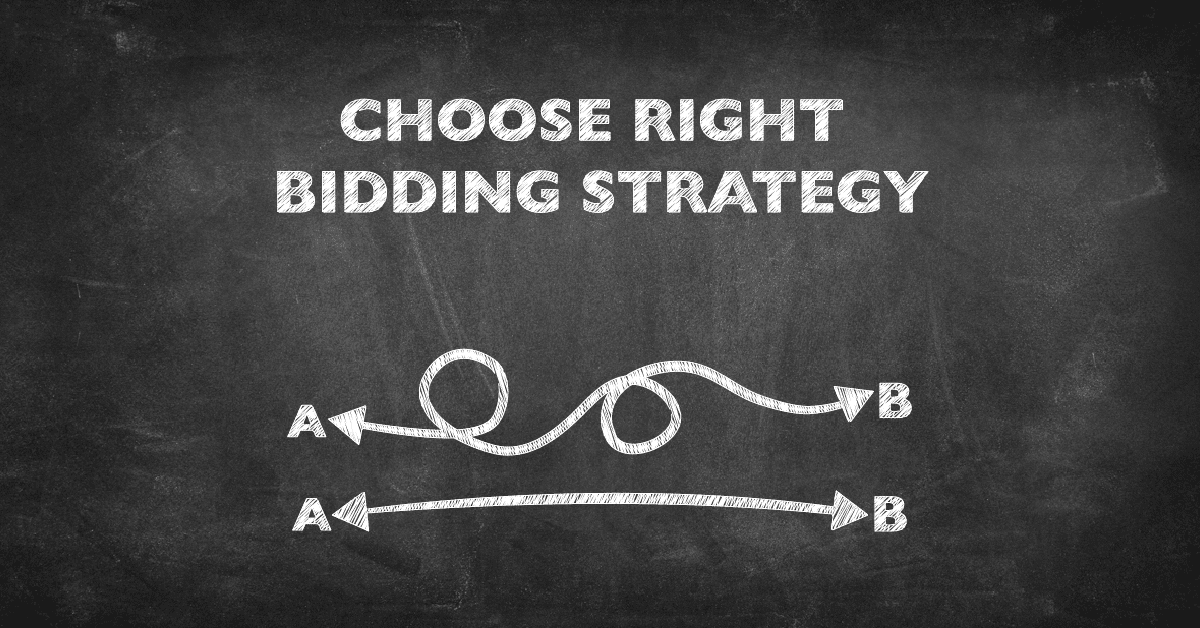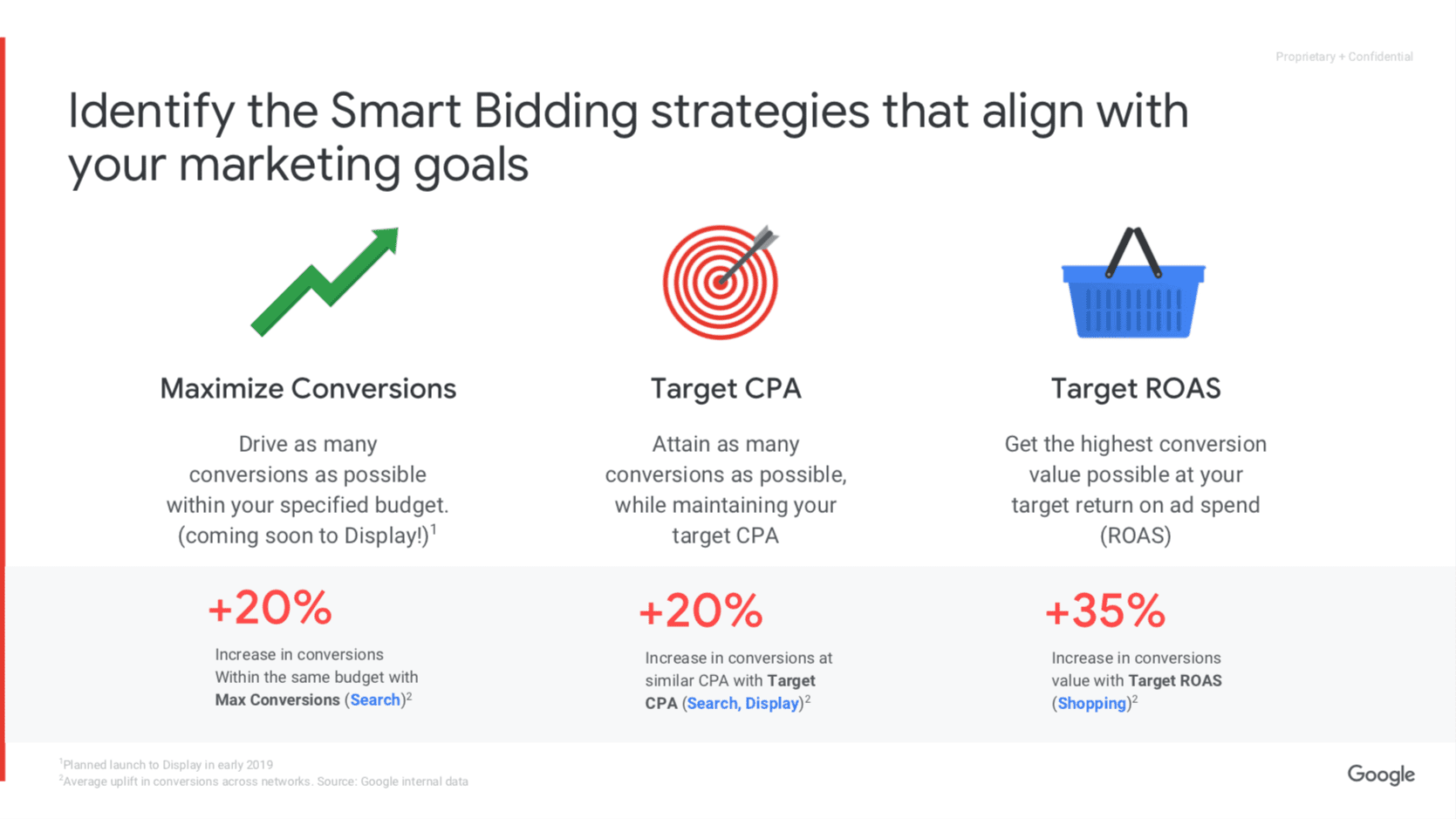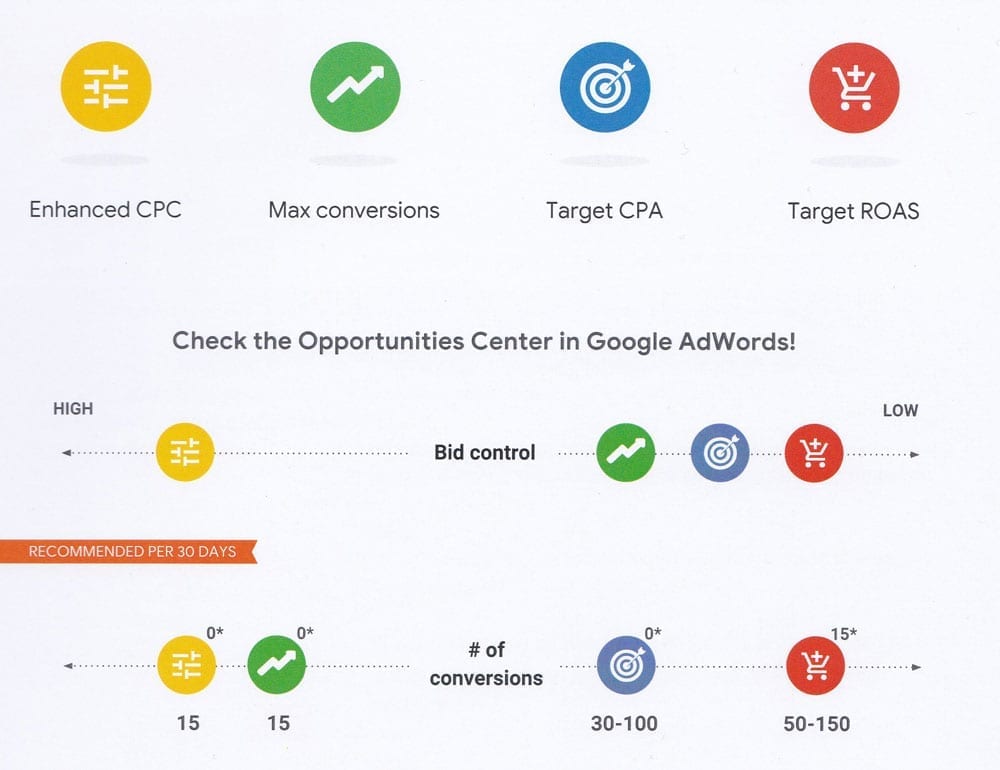A good text for your ad is only one part of success when attracting new potential customers. The other is the implementation of adequate strategy for bidding, so that you get the maximal results on the minimal ad price. If you do not pay enough attention to bidding, you may end up paying much more.
In this article we will introduce to you bidding possibilities offered by Google Ads and their characteristics, so in the end you will be able to choose the most convenient one for your business.
Google Ads bidding: Consider your goals
Since each strategy performs differently, it is important first of all to set the goal you want to achieve – clicks, impressions, conversions or views.
Choose right bidding strategy depending on Bid control and number of Conversions (in last 30 days):
Focus on conversions with Smart Bidding
If your goal is defined by conversions, consider running Google Smart Bidding. The system will automatically valorize your bids. Choose one of these strategies:
Target Cost per Acquisition (target CPA): This option becomes easy as soon as you to define your acquisition costs. Acquisition is an amount of money you can afford to spend on acquiring one customer. Then you just enter your target CPA and this method is ready to start. It is ideal to optimize conversions. GoogleAds will focus on converting users at a specific acquisition cost. Bids will be set automatically on your campaigns based on your CPA. Some conversions may cost more than the others to even out and align with your acquisition costs. You can learn more about Target CPA bidding here,
Target Return on Ad Spend (target ROAS): This one could be the most surprising one, because it is based on maths. GoogleAds will set your bids to maximize conversion value based on the return you want from your ad spend. When entering your goal into GoogleAds, you have to enter the target value. You have to calculate it. If you need a little hint, modify your columns for keywords on a recent campaign with Conv. value/cost metrics. Then use the number from your top performing campaign as your Target ROAS. You can learn more about Target ROAS bidding here.
Maximize Conversions: This could be the easiest strategy offered. You only have to set the maximum daily budget, which will Google use for automatically running your bidding, getting you the most conversions for your money. At the end of the campaign, check the return on investments to see if the maximizing of conversions led to profitable sales. More about Maximize Conversions you can find here.
Enhanced CPC (ECPC): This method adds several automated features to your manual CPC settings, giving you greater flexibility. Google can increase or decrease your bid on the likelihood of driving the sale. Bids will try to be averaged out at your max cost per click settings. If the search in too competitive, Google will lower your bid to cost less due to decreased chances of converting. You can see more about Manual CPC bidding here.
Focus on clicks with CPC bidding
You can focus on gaining clicks and driving traffic to your website using cost per click (CPC) in two separate strategies:
Maximize Clicks: This automated strategy is based on your maximum daily budget. Google will attempt to acquire the most clicks possible with your daily budget and drive traffic on your webpage. This could be a good solution for when your budget is too tight. More about biddiing strategy Maximize clicks you find here.
Manual CPC bidding: This is one of the default and most time-consuming strategies, for it gives you total control over your bids. Because of its complexity, it is not recommended for Google Ads newbies. You will be setting bids for different groups or placements, adjusting it accordingly to the needs of specific campaigns. It can be combined with ECPC (analyzed later), which will allow you control budgets and allow Google to adjust bids based on the likelihood of converting at the same time. You can find more about Manual CPC here.
Focus on Impressions within Google Ads bidding
If you are seeking more impressions for your ad, here are several strategies to maximize your visibility.
Target Search Page Location (TSPL): Choosing this method, you will simply allow Google to automatically adjust the bids to always show your ads either on the top of first page of Google results or anywhere on the first page of Google. You can read more about strategy Target Search Page Location here.
Target Outranking Share: Optimal strategy for competitor targeting and brand awareness raising on Google Ads, allowing you to outrank a specific website or competitor. When there are both of the ads displaying, Google will increase your bids to outrank the others. The settings are simple. Firstly, set the domain to outrank. Then the percentage of times you want to bid to rank on top of them. Be careful. The higher the percentage, the more you may pay for click. More about strategy Target Outranking Share you can find here.
Cost-per-thousand impressions (CPM): using this strategy, you pay for impressions (times your ads are shown). You pay for impressions you receive on Google Display Network (and also on Youtube).
Cost-per-thousand viewable impressions (vCPM): using this manual bidding strategy you can serve your ads to increase awareness. This bidding strategy is suitable when you do not need necessarily generate clicks or conversions. This strategy let you pay for each 1,000 viewable ad impressions on the Google Display Network. You can learn more about this strategy here.
Bidding strategy – Pro Tips:
- Carefully set targets when using Smart Bidding (tCPA, tROAS) – this is important becase Smart Bidding algorithms works best when optimize campaign toward realistic goal.
- After change of strategy, minimize changes – there is learning period, when you change bidding strategy. Wait until learning period ends and only after do needed changes.
- Avoid immediate analysis of Smart Bidding perfomance – smart bidding algoritms need time to learn, so wait until learning period is complete to have more data and better perfomance.
- Seasonality trends – be mindful about seasonality, because seasonal events often results in sudden, drastic shifts in perfomance. All these changes can impct your Smart bidding campaigns. When seasonal volume spikes, all strategies respond positively, so you do not need to adjust your bidding.







